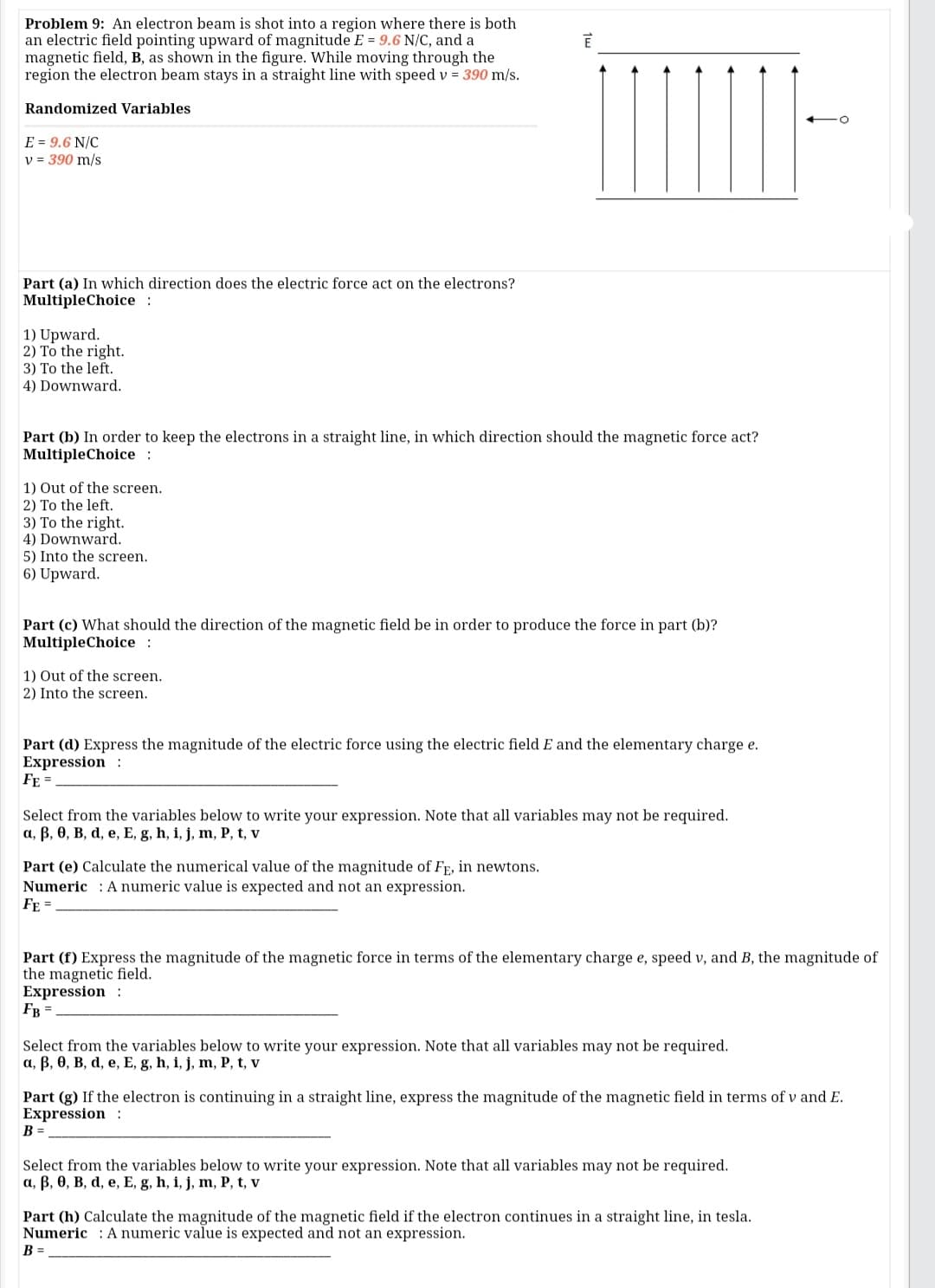Problem 9: An electron beam is shot into a region where there is both an electric field pointing upward of magnitude E = 9.6 N/C, and a magnetic field, B, as shown in the figure. While moving through the region the electron beam stays in a straight line with speed v = 390 m/s. Randomized Variables E = 9.6 N/C v = 390 m/s Part (a) In which direction does the electric force act on the electrons? MultipleChoice: 1) Upward. 2) To the right. 3) To the left. 4) Downward. Part (b) In order to keep the electrons in a straight line, in which direction should the magnetic force act? MultipleChoice: 1) Out of the screen. 2) To the left. 3) To the right. 4) Downward. 5) Into the screen. 6) Upward. Part (c) What should the direction of the magnetic field be in order to produce the force in part (b)? MultipleChoice : 1) Out of the screen. 2) Into the screen. Part (d) Express the magnitude of the electric force using the electric field E and the elementary charge e. Expression : FE =
Problem 9: An electron beam is shot into a region where there is both an electric field pointing upward of magnitude E = 9.6 N/C, and a magnetic field, B, as shown in the figure. While moving through the region the electron beam stays in a straight line with speed v = 390 m/s. Randomized Variables E = 9.6 N/C v = 390 m/s Part (a) In which direction does the electric force act on the electrons? MultipleChoice: 1) Upward. 2) To the right. 3) To the left. 4) Downward. Part (b) In order to keep the electrons in a straight line, in which direction should the magnetic force act? MultipleChoice: 1) Out of the screen. 2) To the left. 3) To the right. 4) Downward. 5) Into the screen. 6) Upward. Part (c) What should the direction of the magnetic field be in order to produce the force in part (b)? MultipleChoice : 1) Out of the screen. 2) Into the screen. Part (d) Express the magnitude of the electric force using the electric field E and the elementary charge e. Expression : FE =
Principles of Physics: A Calculus-Based Text
5th Edition
ISBN:9781133104261
Author:Raymond A. Serway, John W. Jewett
Publisher:Raymond A. Serway, John W. Jewett
Chapter19: Electric Forces And Electric Fields
Section: Chapter Questions
Problem 6P
Related questions
Question
can you please ans (a) (b) (c)?

Transcribed Image Text:Problem 9: An electron beam is shot into a region where there is both
an electric field pointing upward of magnitude E = 9.6 N/C, and a
magnetic field, B, as shown in the figure. While moving through the
region the electron beam stays in a straight line with speed v = 390 m/s.
Randomized Variables
E = 9.6 N/C
v = 390 m/s
Part (a) In which direction does the electric force act on the electrons?
MultipleChoice:
1) Upward.
2) To the right.
3) To the left.
4) Downward.
Part (b) In order to keep the electrons in a straight line, in which direction should the magnetic force act?
MultipleChoice :
1) Out of the screen.
2) To the left.
3) To the right.
4) Downward.
5) Into the screen.
6) Upward.
Part (c) What should the direction of the magnetic field be in order to produce the force in part (b)?
MultipleChoice :
1) Out of the screen.
2) Into the screen.
Part (d) Express the magnitude of the electric force using the electric field E and the elementary charge e.
Expression :
FE =
Select from the variables below to write your expression. Note that all variables may not be required.
a, B, 0, B, d, e, E, g, h, i, j, m, P, t, v
Part (e) Calculate the numerical value of the magnitude of FE, in newtons.
Numeric : A numeric value is expected and not an expression.
FE =
Part (f) Express the magnitude of the magnetic force in terms of the elementary charge e, speed v, and B, the magnitude of
the magnetic field.
Expression :
FB =
Select from the variables below to write your expression. Note that all variables may not be required.
a, B, 0, B, d, e, E, g, h, i, j, m, P, t, v
Part (g) If the electron is continuing in a straight line, express the magnitude of the magnetic field in terms of v and E.
Expression :
B =
Select from the variables below to write your expression. Note that all variables may not be required.
a, B, 0, B, d, e, E, g, h, i, j, m, P, t, v
Part (h) Calculate the magnitude of the magnetic field if the electron continues in a straight line, in tesla.
Numeric : A numeric value is expected and not an expression.
B =
Expert Solution
This question has been solved!
Explore an expertly crafted, step-by-step solution for a thorough understanding of key concepts.
This is a popular solution!
Trending now
This is a popular solution!
Step by step
Solved in 2 steps with 2 images

Knowledge Booster
Learn more about
Need a deep-dive on the concept behind this application? Look no further. Learn more about this topic, physics and related others by exploring similar questions and additional content below.Recommended textbooks for you

Principles of Physics: A Calculus-Based Text
Physics
ISBN:
9781133104261
Author:
Raymond A. Serway, John W. Jewett
Publisher:
Cengage Learning

Physics for Scientists and Engineers: Foundations…
Physics
ISBN:
9781133939146
Author:
Katz, Debora M.
Publisher:
Cengage Learning

Principles of Physics: A Calculus-Based Text
Physics
ISBN:
9781133104261
Author:
Raymond A. Serway, John W. Jewett
Publisher:
Cengage Learning

Physics for Scientists and Engineers: Foundations…
Physics
ISBN:
9781133939146
Author:
Katz, Debora M.
Publisher:
Cengage Learning